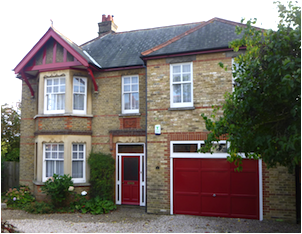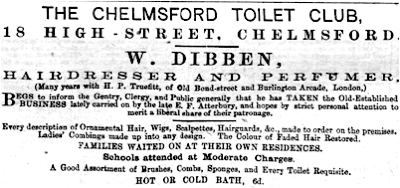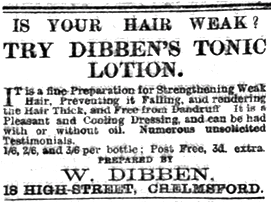Harold William Dibben was born and brought up in Chelmsford. He worked as a shipping clerk and joined the army in September 1914. In December 1915 he obtained a commission as an officer. He was killed in action near Arras in April 1917. His family home was in Roxwell Road.
DIBBEN, HAROLD WILLIAM,
2nd Lieutenant, 4th Battalion, King's Shropshire Light Infantry (formerly of the Royal Engineers)
Harold was educated at Chelmsford College in Arbour Lane, Springfield - the school later became the site of the Marconi College. By 1909 Harold’s father had opened another shop in Brentwood High Street.
The 1911 census found 20 year-old Harold living with his parents, sister Lilian and a domestic servant at Hillcrest in Roxwell Road, Chelmsford. Harold was a shipping clerk, for the Royal Mail Steam Packet Co; his father was ‘an artistic hair worker’.

Harold was born in Chelmsford on 11th November 1890, the only son of William Dibben and Ellen Dibben (nee Lloyd). His father had been born in 1851 in Poole, Dorset; his mother in 1857 in Reading, Berkshire.
The couple had married at St. Peter’s Church n Paddington London on 14th June 1877. At the time Harold’s father was 26 year-old hairdresser, resident at 4 Sutherland Gardens, London. His bride was aged 20 and lived 6 Third Avenue, Queen’s Park, London.
WIthin the next couple of years the couple had moved to Maldon where Harold’s only sibling, Lilian Louise Dibben was born in 1878. The 1881 census had found Harold’s
mother and sister at High Street, Maldon. His mother was described as a ‘hairdresser’s wife’. Harold’s uncle. Charles Dibben, was also resident in Maldon where he ran his own hairdresser’s business.
In 1892 Harold’s family moved to Chelmsford after his father had taken over the hairdresser and perfumer business of the late E. F. Atterbury at 18 High Street, an event that was advertised in the Essex County Chronicle. The advert mentioned that Harold’s father had ‘worked for many years for H. P. Trondit of Old Bond Street and Burlington Arcade in London.’

Five month-old Harold was recorded by the 1891 census living with his parents, sister and a servant still at 18 High Street. His father was a hairdresser.
On Midsummer’s Day 1897 Essex was struck by a tornado, thunder, lightning, driving rain and the fall of tons of hailstones, many larger than walnuts, with one
six and a half inches in circumference falling at Little Baddow. The event caused considerable damage in Chelmsford, with many of the High Street premises’ doorways blocked by the hail stones. A local newspaper repport explained the effect the storm had on the town and mentioned Harold:
“Many pathetic incidents occurred during the storm. The six-year-old son of Mr. W. Dibben of High Street, Chelmsford, was greatly terrified. After crying out and shrieking for a long time he suddenly pulled himself together and observed to his father, who was engaged in stopping the rush of the water into his premises, ‘Never mind, father, God has promised not to drown us.”
The 1901 census listed ten year-old Harold living with his parents at 8 Meadowside, Springfield, along with his parents and sister Lilian. His father still ran his hairdresser and perfumer business in the High Street.

However, the hairdressing business was to run into trouble: in late 1905 Harold’s father was declared bankrupt. Nevertheless he opened a new shop in Duke Street owned by his wife, while his home and his furniture were protected as they were also in his wife’s name. In july 1906 he was discharged from bankruptcy at Chelmsford County Court. A Chelmsford newspaper reported:
“MR. DIBBEN GETS HIS DISCHARGE FROM BANKRUPTCY.
Wm. Dibben, hairdresser, of Chelmsford, applied for his discharge from bankruptcy. —The Official Receiver said the receiving order was made on Oct. 19, 1905, the debtor's own
petition, and the order adjudication was made on the same day. The liabilities expected to rank for dividend were estimated at 9s. 4d., but the proofs admitted came to .£676 14s. The assets, estimated to produce 15s. 2d., realised .£154 os. Id. first and final dividend of 2s. the £ had been paid. The debtor's conduct during bankruptcy had been satisfactory. The debtor began business at 18 High-street, Chelmsford, in August, 1883, with a capital of had kept record of the cash expended, and had not made out any balance-sheets. The facts that he had to borrow money at a high rate of interest, probably 50 or 60 per cent., and that he had to incur heavy expenses respect of repairs to the premises, showed that he was hopelessly insolvent for some years prior to the receiving order, although debtor said at his public examination that he was not aware the fact. The debtor attributed his insolvency to large expenses incurred under the repairing lease of the premises he then occupied. He had omitted to keep proper books of account, had continued trade after knowing himself to be insolvent, and had contracted a debt without reasonable or probable ground of expectation of being able to pay it. He (the Official Receiver) did not press these things.—His Honour said it was not a bad case, and the discharge would be granted, suspended for the minimum period of two years.”

On 4th September 1914 Harold attested at Chelmsford to join the Royal Engineers where he became Sapper 49081. He was 23 years and nine months old and employed as a shipping clerk. Harold was five feet four and a half inches tall, weighted 122 pounds, with a chest of 35 and a half inches. He had a fresh complexion, blue eyes and brown hair. He was a member of the Church of England. It was intended that Harold would be a motor fitter. His next of kin was his father of Northfield, Rainsford Road, Chelmsford (today’s number 1 Roxwell Road, pictured).
Harold’s initial posting was to Chatham, Kent. but on 15th November 1914 he was transferred to the 33rd Signal Company. He arrived at Shrewsbury, Shropshire two days later. On 1st May 1915 he was posted to Hitchin, Hertfordshire and on 14th May 1915 he was transferred to the Dunstable Signals Depot where he arrived on 19th May 1915. There he was employed within the pay office.
On 4th October 1915 Harold applied for a commission. By then he had grown to five feet seven inches tall, and described his profession as ‘an accountant’. Five days later he passed a medical and a further two days later he was interviewed at Woburn, Bedfordshire by the officer commanding his unit who confirmed Harold’s eligibility and suitability to be offered a commission with the King's Shropshire Light Infantry.
On 16th December 1915 he was discharged at Houghton Regis, Bedfordshire by the officer commanding the Dunstable Signals Company, having been commissioned into the 3/4th Battalion of the Shropshire Light Infantry. By then he had been in the army for one year and 104 days.
Harold was killed in action on 30th April 1917 by an exploding shell while serving as a Second Lieutenant in the 4th Battalion of the King's Shropshire Light Infantry.
He was buried at Faubourg D'amiens Cemetery, Arras, Pas de Calais, France (grave reference: IV.E.7). The Commonwealth War Games Commission incorrectly recorded his date of death as 30th September 1917.
The Essex County Chronicle of 11th May 1917 reported:
“Sec.-Lt. H. W. Dibben, Shropshire L. I., only son of Mr. W. Dibben, Duke Street and Roxwell Road, Chelmsford, was killed in action on April 30 by a shell while standing with his General, who was uninjured. Deceased, a smart Old Chelmsfordian, enlisted in the Royal Engineers in the first few weeks of the war, and afterwards accepted a commission. He showed great promise, and had acted as an instructor and as adjutant, He was 25 years of age, and was employed by the Royal Mail Packet Steam Co.
Lieut.-Col. K. H. L. Arnott, of his regiment, in a letter to the bereaved parents, wrote: ‘Your son was attached to Brigade Headquarters as signalling officer during the fighting of [censored]. He was a most able and gallant officer, and has done most valuable work with both his battalion and the brigade. Gen. Holmes, commanding the Brigade, who was near him when he was killed, spoke most highly of him, and asked me to convey to you his sincere sympathy.’”
The same edition also carried a family announcement of his death:
“Dibben. - Instantaneously killed by a shell on April 30th in France, Sec.-Lieut. H. W. Dibben, K.S.L.I., aged 25. Beloved and only son of Mr. and Mrs. Dibben, Chelmsford, and dearly loved brother of Mrs. Denny.”
The day’s Essex Weekly News also carried a family announcement:
“Dibben. - Instantaneously killed by a shell on April 30th, Second-Lieut. H. W. Dibben, K.S.L.I., beloved and only son of Mr. and Mrs. W. Dibben, Chelmsford, and dearly-loved brother of Mrs. Denny, aged 26.”
A report of his death was also carried by the same edition:
“Second-Lieut. H. W. Dibben, Shropshire Light Infantry, only son of Mr. W. Dibben of Duke-st. and Roxwell-rd., Chelmsford, was killed in action on April 30. Deceased who was 25 years of age. was a very popular young man and had a large number of friends in the town and district. Before the war he was in the service of the Royal Mail Steam Packet Co., and shortly after the outbreak of hostilities enlisted in the R.E., subsequently being given a commission. He had done excellent work in the Service,having acted as instructor and as adjutant, He was killed by a shell while standing near the General of the Brigade, the latter being uninjured. In a letter to deceased’s parents Lieut.-Col. Kenneth H. L. Arnott, the commanding officer of the Battalion, says: - ‘He was killed absolutely instantaneously but a piece of shell. He was attached to Brigade Headquarters as Signalling Officer, He was a most able and gallant officer, and has done most valuable work in both the Battalion and the Brigade. General Holmes, commanding the Brigade, who was near him when he was killed, spoke most highly of him and his work.’”
Harold is commemorated on the Civic Centre Memorial, Chelmsford and by the Chelmsford Parish Great War Memorial in Chelmsford Cathedral.
The 1918 register of electors listed Harold’s parents living at Northfield. His father’s perfumery was at 22 Duke Street.
131004